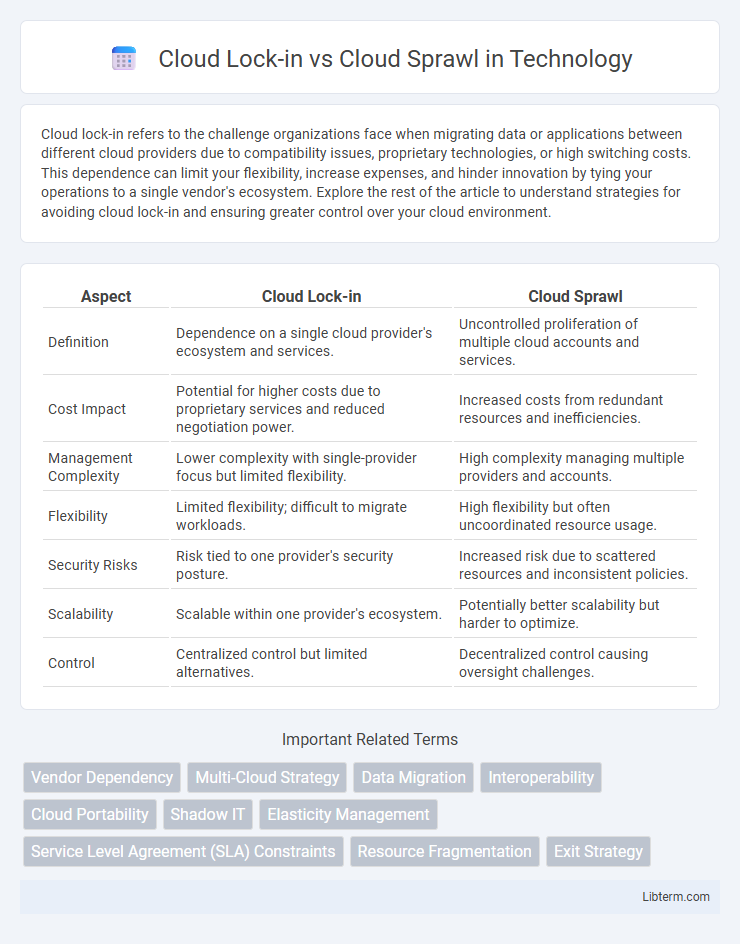Cloud lock-in refers to the challenge organizations face when migrating data or applications between different cloud providers due to compatibility issues, proprietary technologies, or high switching costs. This dependence can limit your flexibility, increase expenses, and hinder innovation by tying your operations to a single vendor's ecosystem. Explore the rest of the article to understand strategies for avoiding cloud lock-in and ensuring greater control over your cloud environment.
Table of Comparison
| Aspect | Cloud Lock-in | Cloud Sprawl |
|---|---|---|
| Definition | Dependence on a single cloud provider's ecosystem and services. | Uncontrolled proliferation of multiple cloud accounts and services. |
| Cost Impact | Potential for higher costs due to proprietary services and reduced negotiation power. | Increased costs from redundant resources and inefficiencies. |
| Management Complexity | Lower complexity with single-provider focus but limited flexibility. | High complexity managing multiple providers and accounts. |
| Flexibility | Limited flexibility; difficult to migrate workloads. | High flexibility but often uncoordinated resource usage. |
| Security Risks | Risk tied to one provider's security posture. | Increased risk due to scattered resources and inconsistent policies. |
| Scalability | Scalable within one provider's ecosystem. | Potentially better scalability but harder to optimize. |
| Control | Centralized control but limited alternatives. | Decentralized control causing oversight challenges. |
Understanding Cloud Lock-In: Definition and Causes
Cloud lock-in occurs when organizations become dependent on a single cloud provider's tools, services, and infrastructure, limiting their ability to switch providers without significant costs or technical challenges. Causes include proprietary APIs, data transfer fees, and unique service configurations that hinder interoperability across different cloud platforms. Understanding these factors helps businesses make informed decisions to balance the benefits of cloud adoption with the risks of vendor dependency.
What is Cloud Sprawl? Key Indicators and Risks
Cloud sprawl refers to the uncontrolled proliferation of cloud resources and services across multiple platforms and accounts, leading to inefficient management and increased costs. Key indicators include overlapping services, underutilized resources, lack of centralized governance, and escalating cloud bills. Risks involve security vulnerabilities, compliance issues, reduced operational efficiency, and difficulty in tracking and optimizing cloud usage.
Comparing Cloud Lock-In and Cloud Sprawl
Cloud lock-in restricts businesses to a single cloud provider's ecosystem, limiting flexibility and increasing dependency on specific technologies, while cloud sprawl refers to the uncontrolled expansion of cloud resources across multiple platforms, leading to inefficiencies and higher costs. Cloud lock-in can simplify management but risks vendor dependency, whereas cloud sprawl offers multi-cloud flexibility but complicates governance and security. Effective cloud strategies balance avoiding lock-in through interoperable solutions and controlling sprawl by implementing centralized cloud management and cost oversight.
Business Impacts of Cloud Lock-In
Cloud lock-in limits business agility by restricting migration between providers due to proprietary technologies, resulting in higher costs and reduced negotiation leverage. Organizations face increased operational risks as dependencies on a single cloud vendor complicate disaster recovery and innovation efforts. This constraint often leads to inefficiencies, stifles competitive advantage, and impacts long-term IT strategy flexibility.
Challenges Posed by Cloud Sprawl
Cloud sprawl creates significant challenges by increasing operational complexity and inflating costs due to unmanaged, redundant resources across multiple cloud environments. This uncontrolled growth undermines governance, making it difficult to maintain security compliance and optimize resource utilization. Organizations face heightened risks of data breaches and inefficiencies, as inconsistent management hampers visibility into cloud assets and spending.
Strategies to Prevent Cloud Lock-In
Adopting a multi-cloud strategy reduces dependency on a single provider, enhancing flexibility and minimizing cloud lock-in risks. Employing containerization and orchestration tools like Kubernetes ensures application portability across different cloud environments. Establishing clear data portability policies and leveraging open standards further prevent vendor-specific constraints while optimizing cloud resource management.
Best Practices for Managing Cloud Sprawl
Effective management of cloud sprawl involves implementing centralized governance frameworks that enforce consistent tagging, resource monitoring, and policy compliance across all cloud environments. Utilizing cloud management platforms with automated cost tracking and optimization tools helps identify underutilized resources and reduce unnecessary expenditures. Establishing role-based access controls and regular audits minimizes shadow IT risks, ensuring cloud resources align with organizational security and budget objectives.
Cost Implications: Lock-In vs Sprawl
Cloud lock-in can lead to increased costs due to limited flexibility in switching providers and potential price hikes from a single vendor. Cloud sprawl incurs higher expenses through unmanaged resource proliferation, resulting in wasted capacity and inefficiencies. Understanding these cost implications helps businesses optimize cloud spending by balancing vendor dependency against uncontrolled expansion.
Tools for Monitoring and Mitigating Cloud Risks
Effective tools for monitoring and mitigating cloud risks include cloud management platforms that provide visibility across multi-cloud environments, enabling detection of cloud sprawl by tracking resource usage and costs. Cloud security posture management (CSPM) tools help prevent cloud lock-in by ensuring consistent policy enforcement and facilitating seamless migration between providers. Automated optimization and governance solutions reduce security risks and optimize expenditures by continuously analyzing cloud assets and usage patterns.
Future Trends in Cloud Management and Governance
Emerging trends in cloud management emphasize strategies to mitigate cloud lock-in by promoting multi-cloud and hybrid cloud architectures that enhance flexibility and vendor independence. Advanced governance frameworks leverage AI-driven analytics and automated policy enforcement to detect and control cloud sprawl, optimizing resource utilization and cost efficiency. Future cloud management platforms will prioritize seamless integration, security compliance, and dynamic resource allocation to balance innovation with operational oversight.
Cloud Lock-in Infographic

 libterm.com
libterm.com